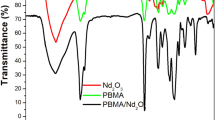Abstract
The nano poly(phenylsilsesquioxane) spheres (nano-PPSQ) were prepared by the sol–gel method and incorporated into poly(methyl methacrylate) (PMMA) by in situ bulk polymerization of methyl methacrylate. The structure of nano-PPSQ was confirmed by transmission electron microscope and thermogravimetry analysis (TG). The interaction between nano-PPSQ and PMMA was investigated by Fourier transform infrared spectra (FT-IR). The influence of nano-PPSQ on the thermal stability of PMMA was investigated by TG and differential scanning calorimetry (DSC) measurements. The results indicated that nano-PPSQ enhanced the thermal stability and the temperatures of glass transition (T g) of nanocomposites. The effect of the heating rate in dynamic measurements (5–30 °C min−1) on kinetic parameters such as activation energy by TG both in nitrogen and air was investigated. The Kissinger method was used to determine the apparent activation energy for the degradation of pure PMMA and nanocomposites. The kinetic results showed that the apparent activation energy for degradation of nanocomposites was higher than that of pure PMMA under air.











Similar content being viewed by others
References
Marinovic-Cincovic M, Popovic MC, Novakovic MM, Nedeljkovic JM. The influence of β-FeOOH nanorods on the thermal stability of poly (methyl methacrylate). Polym Degrad Stab. 2007;92:70–4.
Laachachia A, Cocheza M, Ferriola M, Lopez-Cuestab JM, Leroy E. Influence of TiO2 and Fe2O3 fillers on the thermal properties of poly(methyl methacrylate) (PMMA). Mater Lett. 2005;59:36–9.
Kuan HC, Chiu SL, Chen CH, Kuanl CF, Chiang CL. Synthesis, characterization, and thermal stability of PMMA/SiO2/TiO2 tertiary nanocomposites via non-hydrolytic sol–gel method. J Appl Polym Sci. 2009;113:1959–65.
Kandare E, Deng HM, Wang DY, Hossenlopp JM. Thermal stability and degradation kinetics of poly(methyl methacrylate)/layered copper hydroxymethacrylate composites. Polym Adv Technol. 2006;17:312–9.
Chatterjee A. Effect of nanoTiO2 addition on poly(methyl methacrylate): an exciting nanocomposites. J Appl Polym Sci. 2010;116:3396–407.
Lerari D, Peeterbroeck S, Benali S, Benaboura A, Dubois P. Use of a new natural clay to produce poly(methylmethacrylate)-based nanocomposites. Polym Int. 2010;59:71–7.
Sankaraiah S, Lee JM, Kim JH. Preparation and characterization of surface-functionalized polysilsesquioxane hard spheres in aqueous medium. Macromolecules. 2008;41:6195–204.
Kim YB, Kim YA, Yoon KS. Preparation of functionalized polysilsesquioxane and polysilsesquioxane-metal nanoparticle composite spheres. Macromol Rapid Commun. 2006;27:1247–53.
Takahashi K, Tadanaga K, Matsuda A, Hayashi A, Tatsumisago M. Thermoplastic and thermosetting properties of polyphenylsilsesquioxane spheres prepared by two-step acid-base catalyzed sol-gel process. J Sol-Gel Sci Technol. 2007;41:217–22.
Arkhireeva A, Hay JN. Synthesis of sub-200 nm silsesquioxane particles using a modified Stöber sol–gel route. J Mater Chem. 2003;13:3122–7.
Arkhireev A, Hay JN, Oware W. A versatile route to silsesquioxane nanospheres organically modified silane precursors. J Sol-Gel Sci Technol. 2005;51:1688–95.
Takeshi O, Yoshiki C. Poly(methyl methacrylate) (PMMA)-based hybrid materials with reactive zirconium oxide nanocrystals. Polym J. 2010;42:58–65.
Janos M, Bela P. Polymer micro and nanocomposites: structure, interactions, properties. J Ind Eng Chem. 2008;14:535–63.
Dimitris SA, Alexandros KN, George PK. PMMA/organomodified montmorillonite nanocomposites prepared by in situ bulk polymerization. J Therm Anal Calorim. 2010;102:451–60.
Feng Y, Jia Y, Xu HY. Preparation and thermal properties of hybrid nanocomposites of poly(methyl methacrylate)/octavinyl polyhedral oligomeric silsesquioxane blends. J Appl Polym Sci. 2009;111:2684–90.
Wantinee V, Richard LL. Effect of nanoparticles on the thermal stability of PMMA nanocomposites prepared by in situ bulk polymerization. J Therm Anal Calorim. 2011;103:267–73.
Zou DQ, Yoshida H. Size effect of silica nanoparticles on thermal decomposition of PMMA. J Therm Anal Calorim. 2010;99:21–6.
Manring LE, Sogah DY, Cohen GM. Thermal degradation of poly(methyl methacrylate). 3. Polymer with head-to-head linkages. Macromolecules. 1989;22(12):4652–4.
Hirata T, Kashiwagi T, Brown JE. Thermal and oxidative degradation of poly(methyl methacrylate): weight loss. Macromolecules. 1985;18(7):1410–8.
Kissinger HE. Reaction kinetics in differential thermal analysis. Anal Chem. 1957;29(11):1702–6.
Arisawa H, Brill TB. Kinetics and mechanisms of flash pyrolysis of poly(methyl methacrylate) (PMMA). Combust Flame. 1997;109(3):415–26.
Acknowledgements
This study was supported by Nanjing University of Science & Technology Research Funding (No. 2010GJPY045).
Author information
Authors and Affiliations
Corresponding author
Rights and permissions
About this article
Cite this article
Wang, X., Wu, L. & Li, J. Preparation of nano poly(phenylsilsesquioxane) spheres and the influence of nano-PPSQ on the thermal stability of poly(methyl methacrylate). J Therm Anal Calorim 109, 323–329 (2012). https://doi.org/10.1007/s10973-011-1619-1
Received:
Accepted:
Published:
Issue Date:
DOI: https://doi.org/10.1007/s10973-011-1619-1




